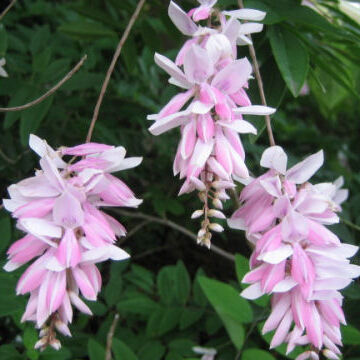Mostly twining vines, seldom shrubby. Leaves even pinnate; leaflets mostly numerous, mucronate; rachis grooved, mucronate; stipels minute; stipules per-sistent. Inflorescences axillary or lateral pseudoracemes, terminating leafy or leafless branches, with 1-several sessile flowers at a node; bracts and bracteoles often caducous. Flowers with the calyx campanulate, lobed or short toothed; standard apically notched and with a short claw, the wing petals shorter than the keel petals; stamens 9, monadelphous, the staminal tube adnate to the standard; style curved, glabrate. Legume oblong to linear, much compressed or not, the valves pubescent, often becoming indurated, septate, the short slender beak downturned; seeds ovoid, sometimes compressed, arillate, sometimes with an annulus around the hilum.
Inflorescence axillary or terminal, the flowers in fascicles on short reduced branchlets, often arranged unilaterally on the rachis, or rarely sessile in the axils; bracts and bracteoles present.
Seeds subglobose or ellipsoid and compressed, sometimes bright red and black; rim aril sometimes developed, usually minute or absent.
Stipules small, usually persistent; stipels filiform; rachis projecting beyond the last pair of leaflets.
Morphological characters and geographic distribution are the same as those of the tribe.
Ovary subsessile, many-ovuled; style not bearded; stigma capitate.
Pods linear or oblong, subturgid or compressed, or ± septate.
Standard ovate to round, with a short broad claw, glabrous.
Flowers small, white, yellow, pink or dark purple.
Upper stamen absent.

